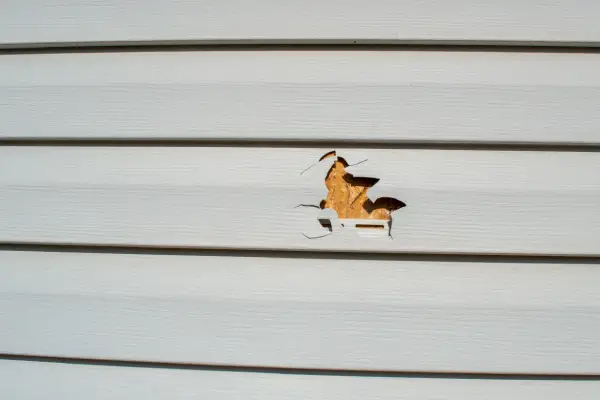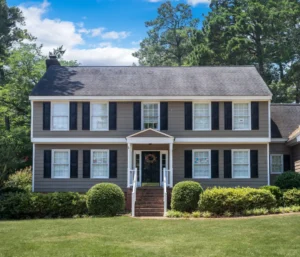
Average Siding Lifespan
The lifespan for wood or vinyl siding, which is what most people have, is about 20 to 30
That’s a big range, which can be explained by two main factors:
- The amount of wear and tear it receives
- How much maintenance it gets
Well-maintained siding can look great after 25 to 30 years – or even more. On the other hand, if you neglect routine siding maintenance, you may need to replace it sooner than you would like.
Ready to Get Started?
Click below to leave your information and we will call you right back!
How Long Does Vinyl Siding Last?
Vinyl siding is durable. In most cases, you can expect it to last 20 to 30 years or more. Without proper maintenance and care, vinyl siding can begin to fade, warp, or crack over time. Replace when you notice panels buckling, gaps appearing, or insulation behind the siding feels damp.
When Should You Replace Your Vinyl Siding?
 There are a few signs that your siding is reaching the end of its useful lifespan and needs to be replaced. Look for the following signs of damaged or aging siding.
There are a few signs that your siding is reaching the end of its useful lifespan and needs to be replaced. Look for the following signs of damaged or aging siding.
If you notice one or more of these, it’s a clear sign that it might be time to replace your siding:
- Peeling, bubbling, or faded siding: These are clear indicators of wear and tear, often due to sun exposure or age.
- Loose or missing siding: This can expose your home to the elements, leading to further damage.
- Cracked or warped siding panels: This can compromise the structural integrity and insulation of your home.
- Moisture problems, rot, mold, or mildew growth (inside the home or out): These issues suggest that your siding is no longer effectively protecting your home from water.
- Too many paint layers and want to repaint: While not a sign of damage, excessive paint layers can sometimes lead to an uneven or unattractive finish.
- Leaky insulation leading to uneven temperatures and/or rising energy bills: This indicates that your siding is no longer providing adequate thermal protection.
- Frequent pest infestations: Siding damage can create entry points for pests, leading to infestations.
How Long Does Wood Siding Last?
Wood siding has a similar lifespan to vinyl siding. Its lifespan is affected by the same factors, but to a greater extent. For example, poorly maintained wood siding will last much less than the 20 to 30 year baseline. This is because it’s highly vulnerable to rot and damage.
However, well-maintained wood siding can last longer than 30 years. In that way, wood siding is both more durable and more sensitive to outside conditions.
When Should You Replace Your Wood Siding?
- Widespread rot: The wood is soft, spongy, or crumbles when poked.
- Warping and buckling: Boards are no longer flat against your home.
- Large cracks or holes: Obvious, numerous openings that expose what’s underneath.
- Interior water damage: You see moisture stains or peeling paint on walls inside your house.
How Long Do Other Types of Siding Last?
- Fiber cement siding: Highly durable, but can develop cracks or chips if moisture seeps into joints. Consider replacing if you see cracking, swelling, or loose panels. With proper maintenance, this type of siding can last 25 to 50 years or more.
- Aluminum siding: Lightweight and fire-resistant, but susceptible to dents and corrosion. Consider replacement when you notice extensive corrosion, large dents, or fading that goes beyond refinishing. Aluminum siding should last you 20 to 30 years or more.
- Engineered composite siding: Mimics wood but resists rot and insects. Watch out for delamination, warping, or color fading. It often lasts 30 or more years.
Ready to Get Started?
Click below to leave your information and we will call you right back!
How to Maximize the Lifespan of Your Siding
 To get the maximum life out of your siding, follow these best practices—each simple step can add years to your home’s protection and curb appeal:
To get the maximum life out of your siding, follow these best practices—each simple step can add years to your home’s protection and curb appeal:
- Clean regularly: Wash your siding at least once a year with a soft brush or pressure washer on a low setting to remove dirt, pollen, and mildew.
- Inspect and repair promptly: Walk the perimeter of your home seasonally. Look for cracks, loose panels, or damaged caulking and address them immediately to prevent water infiltration.
- Maintain gutters and downspouts: Keep gutters clear of leaves and debris so water is directed away from your siding instead of spilling down and causing rot or staining.
- Trim vegetation: Prune bushes, vines, and tree branches at least 12 inches away from walls to reduce moisture buildup and prevent abrasion.
- Repaint or reseal when needed: For painted or wood siding, plan to repaint or reseal every 5–10 years, depending on exposure, to protect against UV and moisture damage.
- Check flashing and seals: Ensure that window, door, and roof flashings are intact and that all seals are tight—these are critical points where leaks often start.
- Schedule professional check‑ups: Every few years, have a siding specialist perform a fire risk assessment‑style inspection—catching small issues early saves money and extends your siding’s lifespan.
What Causes Siding to Deteriorate Faster Than Usual?
Even the highest‑quality siding can wear out faster than expected if it’s exposed to harsh conditions or isn’t properly cared for. Keep an eye on these common culprits to help your siding reach its full useful life:
- Moisture and water infiltration: It’s a big issue here in the Pacific Northwest. Persistent rain, clogged gutters, or poor flashing allow water to seep behind siding, leading to rot, mold, and swelling in wood or fiber cement panels.
- Sun and UV exposure: Intense sunlight breaks down paint and protective coatings over time, causing fading, chalking, and brittleness in vinyl, fiber cement, and painted wood surfaces.
- Improper installation: Gaps, uneven seams, or misaligned panels create weak points where water and pests can enter, accelerating material deterioration.
- Physical damage: Weed whackers, hail, or airborne debris can dent, crack, or chip siding, leaving it vulnerable to further damage.
- Lack of routine maintenance: Failure to clean, repaint, or reseal siding at recommended intervals lets dirt, pollen, and moisture build up, promoting decay and staining.
- Contact with vegetation: Bushes, vines, or tree limbs rubbing against siding trap moisture and abrade surfaces, which can lead to peeling or rot.
- Chemical exposure: Harsh cleaners, pool chemicals, or airborne pollutants can degrade paint, primers, and protective finishes, reducing resistance to the elements.
Schedule a Complimentary Siding Inspection
At Dagmar Pros, we understand you’re weighing a couple of tough questions – “when should you replace your siding?” and “are siding repairs enough for now?” – and our goal is to give you the information you need to make an informed decision.
Oftentimes, it’s difficult to know without inspecting the siding first. That’s why we offer complimentary siding inspections in Southwest WA and Portland.
If you’re not sure, give us a call and we’ll send an experienced siding contractor to take a look and provide you with honest recommendations. Reach out to us today to schedule your inspection.
